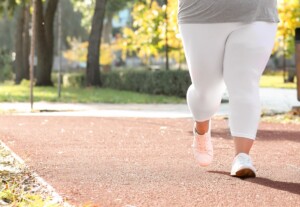Are you trying to lose weight by taking medium or even brisk paced walks after dinner?
How well is this working for your weight loss goals? If not much weight is coming off, here are the reasons.
Taking a walk after the evening meal can be a very relaxing, enjoyable activity. If that’s your only goal, then that’s fine.
But what if you’re using those walks as a way to lose excess body fat?
If you’ve always been sedentary, and then start walking – even at a moderate level of exertion – for one hour after dinner five times a week – this should induce a little weight loss.
But it won’t make you go from 210 pounds to 145 pounds.
Or, to put this another way, it’s highly unlikely it’ll make you go from 145 pounds to 125 pounds.
After Dinner Walks for Weight Loss
There are two problems here.
• The pace is medium and fixed.
• The activity is right after dinner.
Problems with a Steady Medium Pace
Even if the speed is a little faster than what you normally do on the job, while shopping, etc., it isn’t enough to force an adaptive response that results in either significantly improved fitness or much weight loss.
As mentioned, you’ll probably drop a small amount of weight if you’ve always been sedentary.
But you will not keep losing if all you’re doing is comfortably walking – whether it’s after a meal or first thing in the morning.
The more shocking to your body that a training stimulus is, the more the body’s systems will be forced to adapt.
And adaptation requires fuel – which comes from stored body fat.
A moderate walk – one that you can sustain for an hour while conversing with a companion, even though your respiration and heart rate are increased – is not shocking enough to the body to incite substantial weight loss.
Furthermore, walking right after a full meal discourages harder work!
How to Alter Walking to Get Results

Shutterstock/New Africa
Walking after dinner has its place in the enjoyment department, especially if you’re with a companion or your dog.
But if you want to shed every pound on your body that you don’t like, you must do more – but not more of the same thing.
What you should do is interval walking.
Any body can do this because it’s based on subjective effort rather than objective metrics such as time and speed.
You simply walk as fast as you can – wherever you’re walking (on a level street, up a hill of grass, up an inclined hiking trail, across a grassy field) – but this fiery pace is short-lived.
This bursting pace should last 30 to 60 seconds. You should not have the stamina to continue beyond one minute. If you do, go harder.
If you still can’t get the intensity level up high enough, then either walk hills or go into a jog.
The high-effort pace is alternated with a recovery pace – not a crawling pace, but enough to recharge you over a period of one to two minutes, and is then followed by a repeat of the high-effort pace.
This approach causes more overall fat burning because it burns more overall calories.
Plus, if your high-effort intervals are really intense – causing you to be VERY winded upon completion – this will result in a higher resting metabolism for a few hours after the entire workout is finished.
If it takes you just 30 seconds to reach exhaustion after walking only 3 mph on a flat street … then that’s your high-effort interval.
Nevermind that your neighbor requires a 4 mph walk up a steep hill for a whole minute to get out of breath. This is about you, YOU, your subjective experience of exhaustion.
Over time, with this type of training, you will also gain fitness and stamina! And – you’ll lose weight.
Your body will be forced to drop pounds because you’re making it do something for which a leaner body is more efficient at: speedy walking.
Your body will have a reason to shed excess fat, to lighten the load.
Whereas that after-dinner, medium paced walk does NOT give your body any reason to get leaner, because a heavy body can do this as efficiently as a lean body! Makes lots of sense, right?
And as you probably already have figured, interval training should not be done after dinner.
The better time would be prior to dinner, so that dinner could help your body recover from the workout.
Steady State Walking Before Dinner
If you’d rather stick to a fixed pace walk, this should be done before supper. It’s easier to move swiftly when your stomach is empty.
Exercising before a meal may also encourage you to eat that meal mindfully rather than indulge in extra portions of pasta or bread that your body doesn’t need.
For steady state walks, you should increase your pace to what feels like brisk, relative to your fitness level, such that you need to breathe with your mouth open to keep up with the oxygen demands.
Pump your arms, get your heart rate up, and even consider holding one- or two-pound hand weights.
These changes will help with your weight loss goal. But remember, if your weight loss stalls, you should strongly consider interval walking.


























